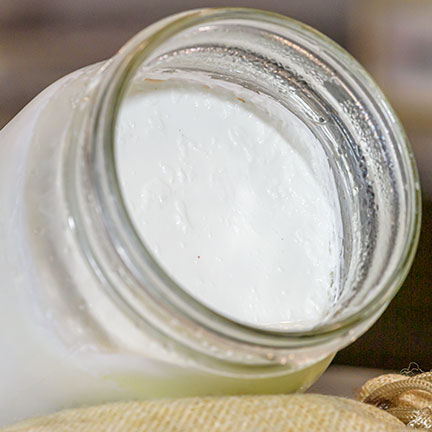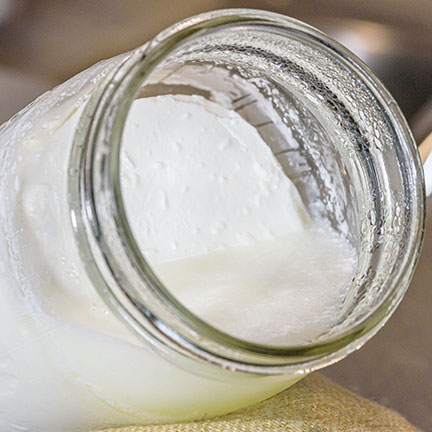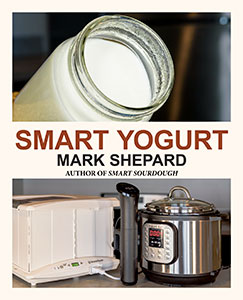While researching my book Smart Yogurt, I was reminded of the importance of good scientific practices—and especially of the need for a control—when I explored the “yogurt” recipes of Dr. William Davis, as given in his book Super Gut.
These recipes are meant to produce yogurt with high probiotic value. But from my very first reading, I was convinced that Dr. Davis hadn’t a clue about cultivating bacteria.
Davis’s method is based on the notion that the population growth of bacteria proceeds in a straight line—in other words, the longer you let it go, the more bacteria you get. But in fact, that growth occurs in a cycle. Yes, the population at first increases rapidly. But eventually, the population gets too big to support itself on the available food or succumbs to its own toxic waste—the same lactic acid we want it to produce!
At that point, the population starts to decline and die off. In a single-species culture warmed for 36 hours—the fermenting time Davis recommends—you might not have many bacteria left alive.
It’s true that Davis reported high bacteria counts from lab tests, but this does not really help his case. As a little research revealed, his lab’s counting technology—called flow cytometry—does not normally distinguish between living and dead bacteria. And notably, his book never says he counted only the living.
Davis seems more up front about this in an online article, “The Arithmetic of Yogurt.” While presenting calculations of L. reuteri population growth, he tells us that, for the sake of simplicity, “We are not accounting for bacterial death.” He then goes on to assure us that even dead L. reuteri is good L. reuteri!
Davis himself warns us that first batches of his recipes are likely to fail, separating into curds and whey. That didn’t surprise me, considering his extra-long incubation and his use of half and half in place of milk. To me, that sounded a lot like a way to make a simple cheese.
What puzzled me, though, was that Davis’s followers reported success with starting later batches from their first one, when the original probiotic should have been dead or severely weakened. According to them, what they were getting was extremely firm and a bit tart. How was that possible?
I finally concluded that the key to the firmness, if not to the taste, was the inulin—an ingredient included in every Davis recipe, but one I had never used or researched. Davis says the inulin is added to provide food for the bacteria during the long ferment. But in commercial yogurt, I learned, it’s used as a stabilizer like pectin or gelatin. It can hold yogurt together if the protein mesh starts to break down, or even solidify a culture that never formed the mesh.
In the end, it looked like Davis’s concoctions weren’t yogurt at all. They were inulin pudding!
It’s one thing to know something for yourself, and another to be able to convince others. For that, I knew I had to do what Davis and his fans seemed to studiously avoid: set up a control. So, I made Davis’s L. reuteri yogurt recipe, using inulin and half and half, just as he instructed—but I left out the L. reuteri.
The result? What I got smelled sour, tasted tart, and as the photo shows, came out completely firm.

To me, this was proof it was inulin, not fermentation, that was firming up Davis’s yogurts. But for members of one Facebook group for probiotic yogurts, this photo was not convincing. Most commenters insisted my culture had become contaminated by other bacteria—from my utensils, or the air in my kitchen, or possibly from the half and half itself.
I had to admit I’d been lax with sanitation in this particular experiment. But I was also intrigued by the idea of contamination from my ingredients—and not just the half and half. Since inulin is a plant product, I wondered if any lactic acid bacteria might be sneaking in on it.
I wrote to the manufacturer of my inulin to ask about that. They assured me their product was sterile, due to the heat used to process it. So, no complications there.
Further research on dairy “contamination,” though, surprised me. I hadn’t realized that even pasteurized milk and cream carry enough live bacteria to eventually sour and thicken them. I learned that cream will turn into crème fraîche, and milk will turn into clabber—not really yogurt, but something you might mistake for it—while combined milk and cream, as in half and half, will turn into sour cream.
After 36 hours, then, there might well be some kind of fermentation, just from the recipe’s half and half. And that fermentation, instead of the inulin or any L. reuteri, would be the likeliest source of this recipe’s tartness.
To test this, I now needed a control for my control. In other words, after experimenting with just half and half plus inulin, I now needed to experiment with half and half by itself! (And this time, with careful sanitation.)
Just like my culture with inulin, the half and half alone started firming in 12 to 15 hours. And in the end, it tasted about the same—not like any yogurt I’ve tasted, but definitely tart. The difference in the final products, though, was that the half and half with inulin had shown very little whey separation, while the half and half alone—again, as seen in the photo—showed a lot!

By now, it seemed clear it was inulin giving Dr. Davis’s “yogurt” its dramatic firmness, while remaining bacteria in the half and half were enough to make it tart. So, neither of these qualities gave any guarantee of L. reuteri’s presence, while the recipe could hardly do better at masking its absence.
Full disclosure: I never did make Davis’s recipe with any L. reuteri!
